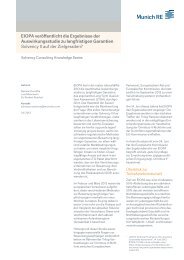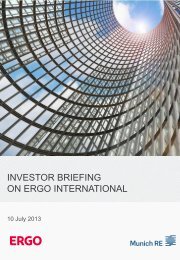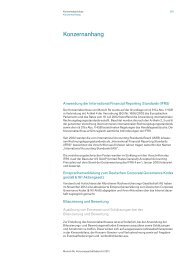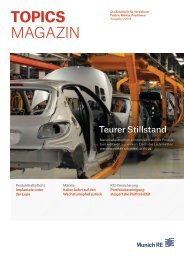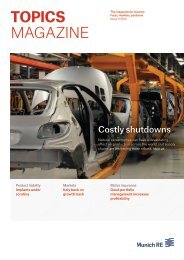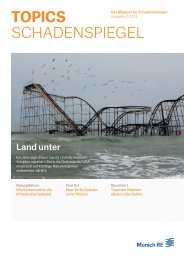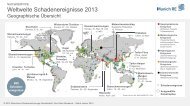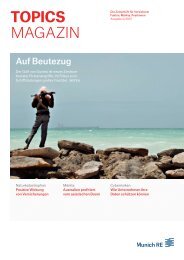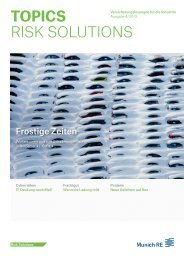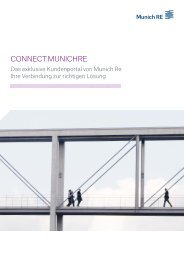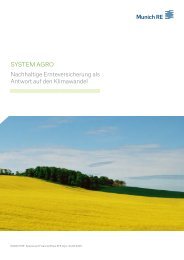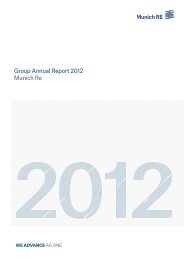Munich Re Group Annual Report 2006 (PDF, 1.8
Munich Re Group Annual Report 2006 (PDF, 1.8
Munich Re Group Annual Report 2006 (PDF, 1.8
You also want an ePaper? Increase the reach of your titles
YUMPU automatically turns print PDFs into web optimized ePapers that Google loves.
<strong>Munich</strong> <strong>Re</strong> <strong>Group</strong> <strong>Annual</strong> <strong>Re</strong>port <strong>2006</strong><br />
modification. This, of course, also<br />
applies to other viruses carried by<br />
animals, because H5N1 is not the only<br />
possible cause of a pandemic. In order<br />
to assess the risk involved, we put our<br />
analyses on a technical and scientific<br />
basis whenever possible.<br />
What are the starting points of your<br />
analyses?<br />
Manuela Zweimüller_ First of all,<br />
we look at historical events. The<br />
Spanish flu of 1918, which killed an<br />
estimated 20 to 40 million people<br />
worldwide, is the most important reference<br />
scenario. However, it cannot<br />
be directly applied to the situation we<br />
have today. We have to bear in mind<br />
that things have changed consider-<br />
20<br />
ably, for example due to enormous<br />
medical advances such as antibiotics<br />
and vaccines. Public and private<br />
hygiene, too, have improved significantly.<br />
There has also been a substantial<br />
increase in overall life expectancy.<br />
This is why it would be inappropriate<br />
to apply last century’s mortality rates<br />
to current population numbers. Starting<br />
from comprehensive historical<br />
and scientific research, we develop<br />
our own scenarios, which are updated<br />
on a regular basis to take account of<br />
trends and developments regarding<br />
the geographical spread of the disease,<br />
vaccination research and other<br />
aspects.<br />
What scenarios are used by <strong>Munich</strong> <strong>Re</strong>?<br />
Manuela Zweimüller_ We are<br />
using a number of scenarios which<br />
differ in key parameters such as the<br />
duration and spread of the pandemic,<br />
and infection and mortality rates. The<br />
WHO scenario with the highest occurrence<br />
probability is comparable to the<br />
Asian flu of 1957/58 and the Hong<br />
Kong flu of 1968, which were both<br />
fairly mild. This scenario did not produce<br />
any pronounced changes to<br />
original mortality rates when we<br />
applied it to selected industrialised<br />
countries. Of course, we have also<br />
looked at a worst-case scenario, although<br />
we do not consider it realistic.<br />
And we are investigating scenarios<br />
which are in between the two extremes.<br />
This has been the basis for<br />
analysing our portfolios. It is important<br />
to bear in mind that a pandemic<br />
would affect a large number of countries<br />
and regions around the world<br />
within a short period of time. This<br />
means that geographical risk diversification<br />
is no longer an option.<br />
What areas of <strong>Munich</strong> <strong>Re</strong> would be<br />
affected by a pandemic, and how is it<br />
preparing for such an event?<br />
Manuela Zweimüller_ First of all,<br />
like any other company, we must<br />
ensure that business can go on when<br />
a pandemic occurs. This is part of our<br />
overall business continuity planning.<br />
The WHO strongly advises all companies<br />
and public authorities to identify<br />
possible shortcomings in this respect,<br />
for example by means of checklists.<br />
Our overall insurance exposure<br />
from a potential<br />
pandemic does not exceed<br />
that from a major natural<br />
catastrophe.<br />
Manuela Zweimüller_ Higher<br />
mortalities and an increased number<br />
of visits to the doctor, hospital admissions<br />
and absences from work as a<br />
result of mass infections would, of<br />
course, primarily affect our life and<br />
health portfolio. Property and casualty<br />
lines (e.g. business closure insurance),<br />
would not be hit nearly as hard, but of<br />
course also contribute to our overall<br />
exposure. We can monitor the pandemic<br />
risk by using the scenarios to<br />
regularly check our portfolios and take<br />
appropriate action if required. And of<br />
course, we closely monitor how the<br />
threat develops by continuously analysing<br />
the official data gathered by<br />
the WHO around the world. Therefore,<br />
the underwriting risk can be assessed<br />
quite accurately. Our overall insurance<br />
exposure from a potential pandemic<br />
does not exceed that from a<br />
major natural catastrophe. What is<br />
most difficult to evaluate, however,<br />
is the impact on the global economy<br />
and, consequently, on the investments<br />
of the <strong>Munich</strong> <strong>Re</strong> <strong>Group</strong>. On the<br />
basis of the WHO scenario which we<br />
consider the most likely, we predict<br />
that the global economy will only be<br />
temporarily disrupted and that the<br />
ensuing shock to the capital markets<br />
will be short term and non-persistent.



